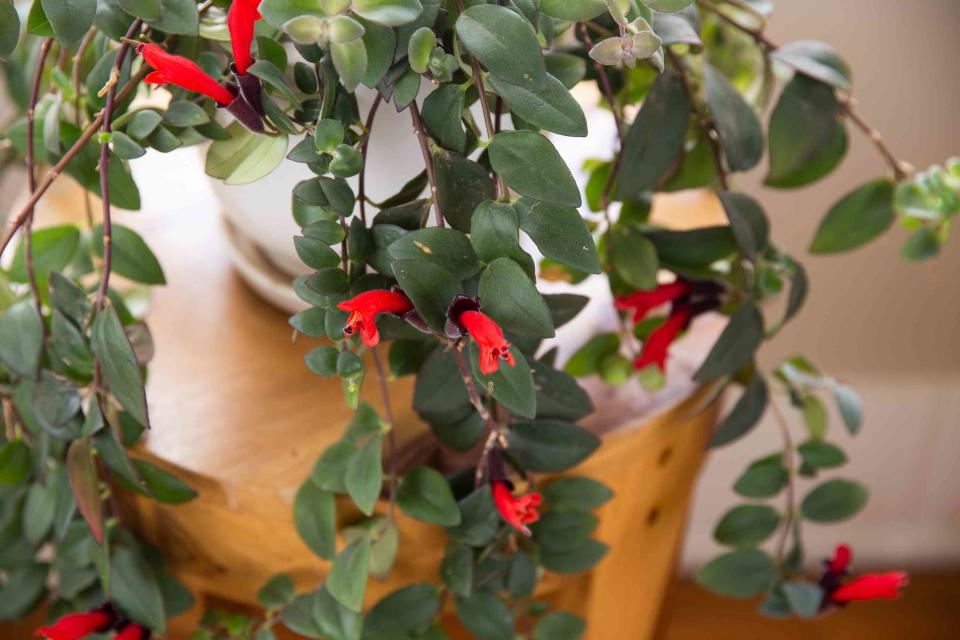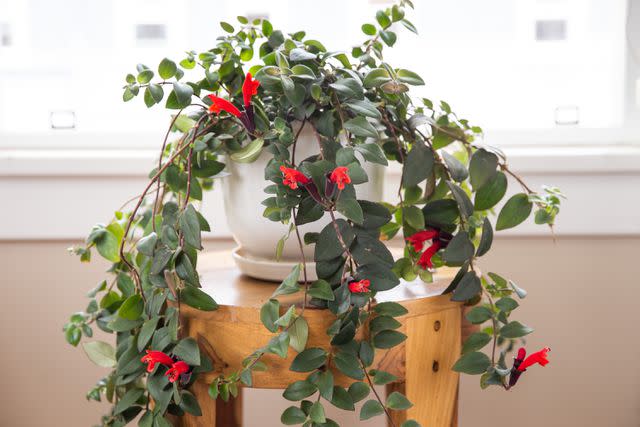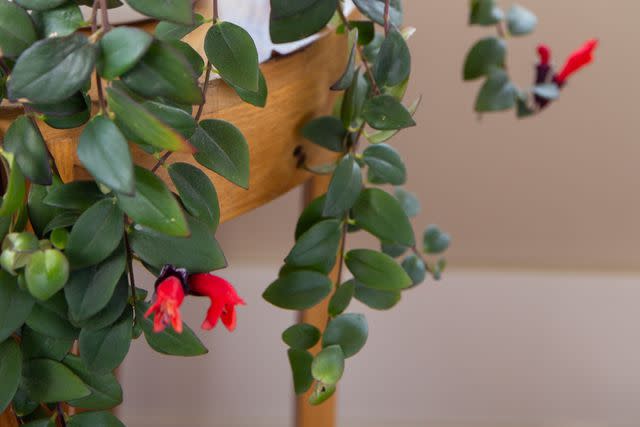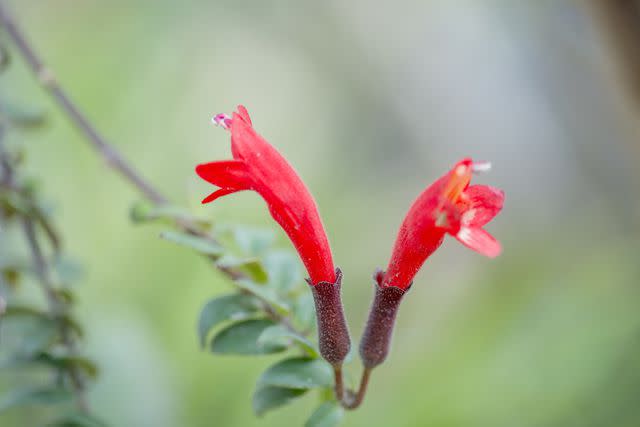How to Grow and Care for Lipstick Plant
A Cascading and Constantly Flowering Houseplant

The Spruce / Krystal Slagle
Reviewed by Mary Marlowe Leverette
The Lipstick plant is a popular, striking tropical evergreen perennial, often grown as a houseplant. It gets its name from its vibrant red tubular flowers. In its native tropical habitat, this is an epiphytic species found growing from tree branches and in cracks in rocks. As a houseplant, it is generally planted in an ordinary well-draining potting mix.
Provided the plant gets enough warmth, humidity, and filtered sunlight, you'll enjoy a prolific display of flowering through much of the year. Generally, though, lipstick plants flower most abundantly in the summer and fall.
Common Name | Lipstick plant, lipstick vine, basket vine |
Botanical Name | Aeschynanthus radicans |
Family | Gesneriaceae |
Plant Type | Evergreen perennial |
Mature Size | 3 ft. long |
Sun Exposure | Bright filtered light |
Soil Type | Very well-drained |
Soil pH | Neutral to alkaline |
Bloom Time | Spring, summer, fall |
Flower Color | Red |
Hardiness Zones | 10b–11a (USDA), usually grown as a houseplant |
Native Area | Asia |

The Spruce / Krystal Slagle

The Spruce / Krystal Slagle

Lipstick Plant Care
Even with its impressive, tropical appearance, the lipstick plant is generally considered to be an easy-to-care-for flowering houseplant. Here are the main care requirements for growing a lipstick plant:
Appreciates a position with bright, filtered light.
Needs higher-than-average humidity levels and protection from sudden temperature changes.
Maintain consistent moisture in the growing season, while being mindful of the plant's sensitivity to overwatering.
Use a loose, well-draining potting mix.
Regularly feed with diluted fertilizer in the growing season.
Light
Lipstick plants need bright but filtered light to thrive. Too much direct sunlight can cause leaf scorch, and too little will result in a poor display of flowering and leaf drop.
Soil
In their native damp and tropical regions, these plants typically grow in an almost soil-free environment often rooting onto branches or rock crevices. Heavy potting soil can cause root rot to develop.
Potted lipstick plants will benefit from being grown in a medium that is well-aerated, evenly moist, and light. Many enthusiasts include sand and sphagnum moss in their mix as this helps ensure good drainage, prevents over-compaction, and promotes absorbency.
Water
Although lipstick plants like consistent moisture, particularly during their most prolific growing period, overwatering and saturated conditions can lead to root rot, leaf drop, and fungal issues.
Moderate watering is best. Ideally, you want to avoid allowing the potting medium to dry out completely and offer water when the top couple of inches are no longer damp.
Temperature and Humidity
Ideal temperatures for healthy blooming lipstick plants range somewhere between 65 and 75 degrees Fahrenheit. Temperatures that fall below 50 degrees Fahrenheit aren't ideal, and leaf drop will usually start to occur. As a tropical species, it appreciates warmth and high humidity; regular misting is recommended to keep the plant healthy. Misting should be done in the morning to discourage fungal leaf spot diseases.
Sudden changes in temperatures and drafts are problematic, too. So it's best not to sit your lipstick plant close beside doors, drafty windows, or air conditioning.
Fertilizer
Your lipstick plant will appreciate regular (once or twice a month) applications of a slow-release fertilizer during the growing season.
Types of Lipstick Plant
Given the lipstick plant's popularity, it's not surprising that a number of cultivars have been developed. Some of the most widely available include:
Aeschynanthus radicans ‘Curly’: The leaves on this cultivar are wavy rather than smooth in appearance, meaning it stands out from the crowd.
Aeschynanthus radicans ‘Mona Lisa’: Known for having a distinctive orange-red shade of flowers rather than the vibrant red of a traditional lipstick plant.
Aeschynanthus radicans ‘Variegata’: The green leaves of this cultivar have tones of yellow, whites, or cream mixed in too.
Aeschynanthus radicans 'Tangerine': This cultivar is unique for its yellow-orange flowers.
Aeschynanthus radicans 'Rasta': This variety has densely curled leaves. The bright red flowers bloom most prolifically in late summer and early fall.
Pruning
With its cascading habit, pruning of the stems can help to prevent the plant from looking straggly. It can also help to encourage new, healthy growth and a fuller appearance.
Propagating Lipstick Plants
These plants are easy to propagate from soft stem cuttings at any time of year. Here's how to do it:
Look for healthy, new growth and cut a piece around five inches long, using sharp pruners. It should be a section without any blooms on it, and all but a few leaves should be removed.
Dip the cut end in powdered rooting hormone.
Plant the cutting in a container containing a mix of vermiculite and perlite.
Keep lightly moist until the plant cutting is rooted, which generally takes about two weeks.
When the cutting is solidly rooted, transplant it into a permanent pot filled with potting mix augmented with sand and sphagnum moss.
How to Grow Lipstick Plants From Seed
Although it's easier to grow these plants from cuttings, it's still possible to germinate lipstick plants from seeds. They should be sown in a warm indoor location. The medium should only just cover the seeds, and they should be kept at a temperature of around 70 to 75 degrees Fahrenheit. Seedlings should begin to germinate in around two weeks.
Potting and Repotting
Repot your lipstick plant when it becomes rootbound and outgrows its current container. Do this in early spring or after the prolific spring and summer bloom season.
Gently remove the root ball from the existing container, carefully shaking off the old potting mix. Cut off any dead roots with sterile scissors or pruning shears. Replant in a pot one to two inches larger than the old one, using fresh, loose, well-draining potting mix.
Common Pests & Plant Diseases
Lipstick plants don't tend to have any major problems with pests, though occasional issues with aphids, mealybugs, and mites can occur. These are best treated with horticultural oils or by washing off the pests with water spray.
If plants are allowed to get overly wet, they can be prone to fungal problems and leaf spot. The leaves should not be left damp, and the potting medium should be well-drained.
How to Get Lipstick Plant to Bloom
You can appreciate year-round red flowers on your lipstick plant if you offer the right care and conditions.
Bloom Months
While lipstick plants can flower year round povided its basic cultural needs are met, blooming is most prolific in spring and summer. Correcting deficits in any of these requirements usually returns the plant to reliable blooming.
What Does the Lipstick Plants Flowers Look and Smell Like?
The lipstick plant features vibrant red tubular flowers that appear above a burgundy bud. These flowers grow in clusters and, along with the waxy, glossy, green foliage, they have a cascading, vine-like habit. This makes them an ideal choice for use in hanging baskets or tall containers.
One thing worth noting is that the lipstick plant isn't one to select to add a fragrant aroma to your home. Although the blooms don't have a strong scent, it isn't particularly pleasant.
How to Encourage More Blooms
Cooler, drier conditions in the winter help buds set for new flowers in the spring. Pruning stems back to around 6 to 8 inches in length after flowering encourages healthy new growth and abundant new blooms.
If you're not seeing many blooms, consider if your lipstick plant is getting too much shade, not enough higher-potassium houseplant fertilizer or the wrong quantities of water.
Frequently Asked Questions
Can lipstick plant be grown as a landscape plant?
It's tricky to grow this plant in garden soil, as it is naturally an epiphytic plant that grows in the cracks of tree bark and appreciates consistent warmth and high humidity. Growing them on patios in hanging baskets that can be moved indoors if temperatures drop is a good strategy. And, if you're lucky, you might find the baskets attract pollinators like hummingbirds, who love their nectar-filled tubular flowers.
Can I move plants outdoors for the summer?
Yes, potted lipstick plants can be moved outdoors onto a patio or deck for the summer months. However, they react badly to temperatures below 60 degrees Fahrenheit. And they like humid conditions, so may resent being outdoors in arid regions, such as the Southwest.
Are there other species in the Aeschynanthus genus to consider?
The genus has more than 150 species, and in addition to A. radicans, several are cultivated as houseplants. A. humilis and A. pulcher, for example, are sometimes sold as houseplants under the common name lipstick plant or lipstick vine. They are similar to A. radicans in their characteristics and care needs.
Read Next:Top Houseplants With Red Flowers

